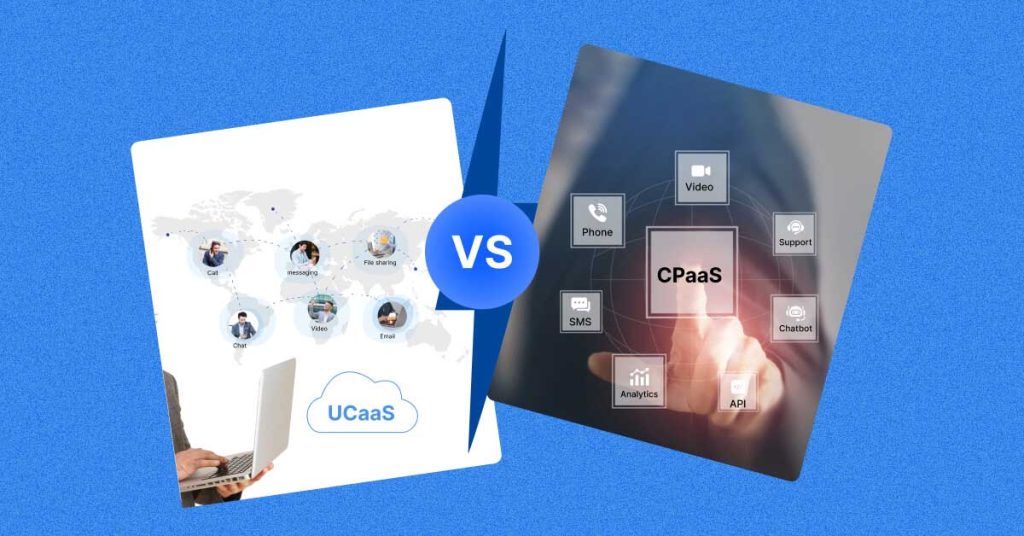
Effective communication is an absolute essential in today’s digital-first business world. Whether it’s about internal collaboration or external customer interactions, a business needs the right communication tools to thrive. Recently, two significant technologies in this space have brought revolution to the way businesses communicate. We’re talking about UCaaS (Unified Communications as a Service) and CPaaS (Communications Platform as a Service). In this blog, we will delve into UCaaS vs CPaaS i.e. understanding the key differences between these two communication solutions.
We will also explore their benefits and limitations to help you decide which one is best for your business or organization.
Sounds interesting? Let’s begin!
UCaaS vs CPaaS: Understanding the Acronyms
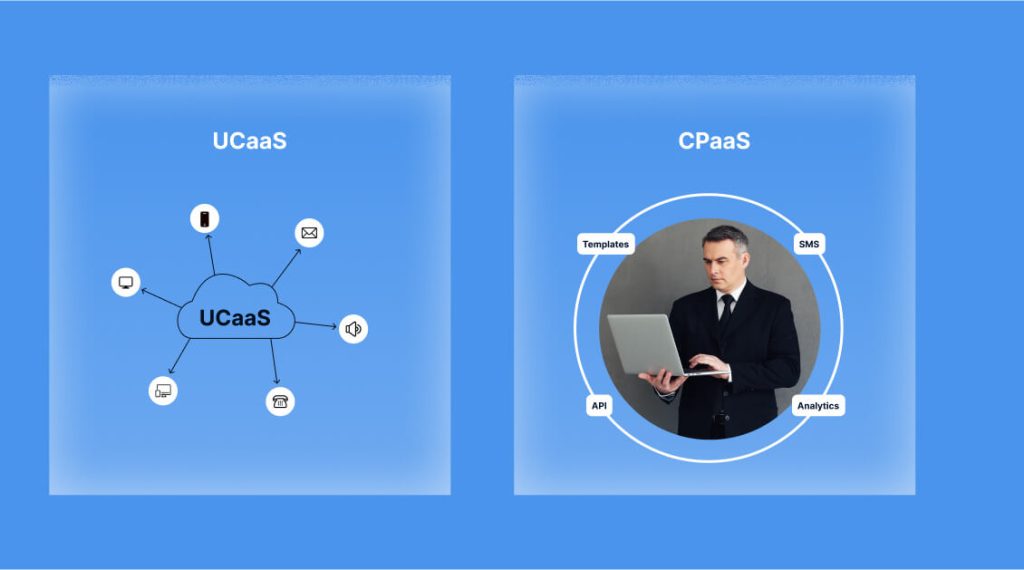
In the business communication landscape, you must have often stumbled upon these two abbreviations – UCaaS and CPaaS. The acronym UCaaS stands for Unified Communication as a Service and the acronym CPaaS stands for Communication Platform as a Service.
Often, companies struggle to manage multiple communication platforms. Implementing UCaaS and CPaaS communication solutions can provide relief. However, in the battle between UCaaS vs CPaaS, it becomes imperative to crack the code behind these two acronyms.
Here’s a table to give you an overview of UCaaS and CPaaS:
| Feature | UCaaS | CPaaS |
| Definition | A cloud-based solution that combines various communication tools (voice, video, messaging, etc.) into a single platform. | A cloud-based platform that provides APIs and SDKs to enable developers to integrate communication features (voice, SMS, video, etc.) into their applications. |
| Key Features | Voice, video conferencing, instant messaging, presence, and collaboration tools. | APIs for voice, video, messaging, and other communication services. |
| Target User | Business users who need a comprehensive communication solution without extensive technical expertise. | Developers who need to build custom communication features into their applications. |
| Pricing Model | Typically subscription-based, often with per-user or per-feature pricing. | Usage-based or subscription-based, depending on the specific features and usage volume. |
| Examples of Use Cases | Internal collaboration, remote work, customer support, contact centers. | Building custom communication apps, SMS notifications, voice bots, IVR systems, IoT applications. |
| Key Benefits | Simplified communication, improved collaboration, increased productivity. | Enhanced customer experience, innovative communication solutions, faster time-to-market. |
Let’s move forward and understand each of these communication solutions in more detail.
What is a UCaaS?
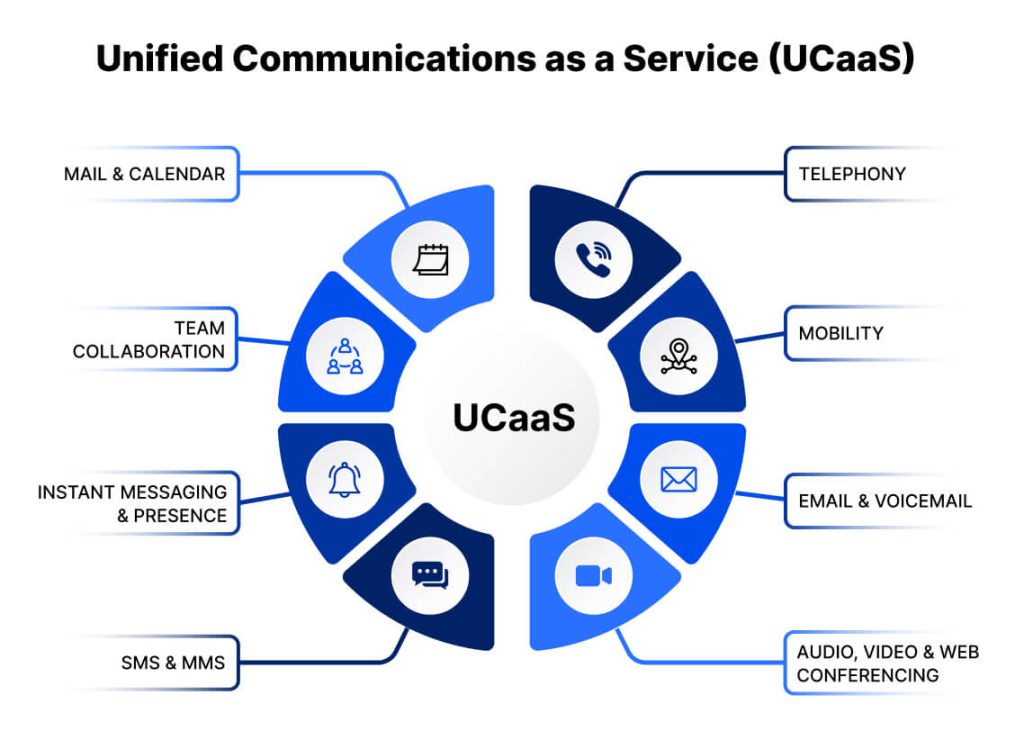
UCaaS is a cloud-based communication solution that combines various communication and collaboration tools into a single, unified interface. Often, this includes voice, video conferencing, messaging, email, screen sharing, and file sharing. You can think of UCaaS as a one-stop shop for all your communication needs.
We have already witnessed how UCaaS companies like Zoom and Microsoft Teams have transformed the workplace collaboration by integrating UCaaS with productivity tools.
And, that’s not all.
UCaaS is much more than convenience. A UCaaS platform being cloud-based allows you to communicate virtually from anywhere using any internet-enabled device. This simply eliminates the need for bulky and expensive VoIP hardware. Moreover, transitioning to cloud also helps you scale up or down, quite easily.
What’s the best part?
UCaaS platforms are straightforward to implement. You and your team don’t need to have technical expertise, because most of the complex backend tasks are managed by UCaaS service providers. This means you can comfortably use the solution and focus on growing your business.
Let’s uncover some interesting insights from the world of UCaaS:
- The UCaaS market is expected to grow from $28.5 billion in 2023 to $112.6 billion by 2033. (Source)
- In terms of regional dominance, North America holds the largest share of the global UCaaS market at 36.14%.
- The BFSI sector holds the highest share of the UCaaS market, while the IT and telecom segment is expected to grow at an 18.5% CAGR.
- By 2030, around 75% of businesses and organizations will switch to UC tools and applications for communication solutions.
Key Features of UCaaS
Most of the UCaaS platforms come packed with features like:
-
Voice calling
The traditional phone calls we have been making for decades need no introduction. This comes with some additional useful features including call recording, voicemail, advanced call routing and call forwarding.
-
Video conferencing
It refers to real-time group video calls that enable multiple participants to connect through video and audio. This is incredibly useful to conduct virtual meetings and conferences.
-
Messaging
This is another useful feature that allows for real-time text-based communication between individuals or even groups.
-
Collaboration tools
There are multiple tools such as file sharing, screen sharing, scheduling and project management that help teams collaborate better.
What is a CPaaS?
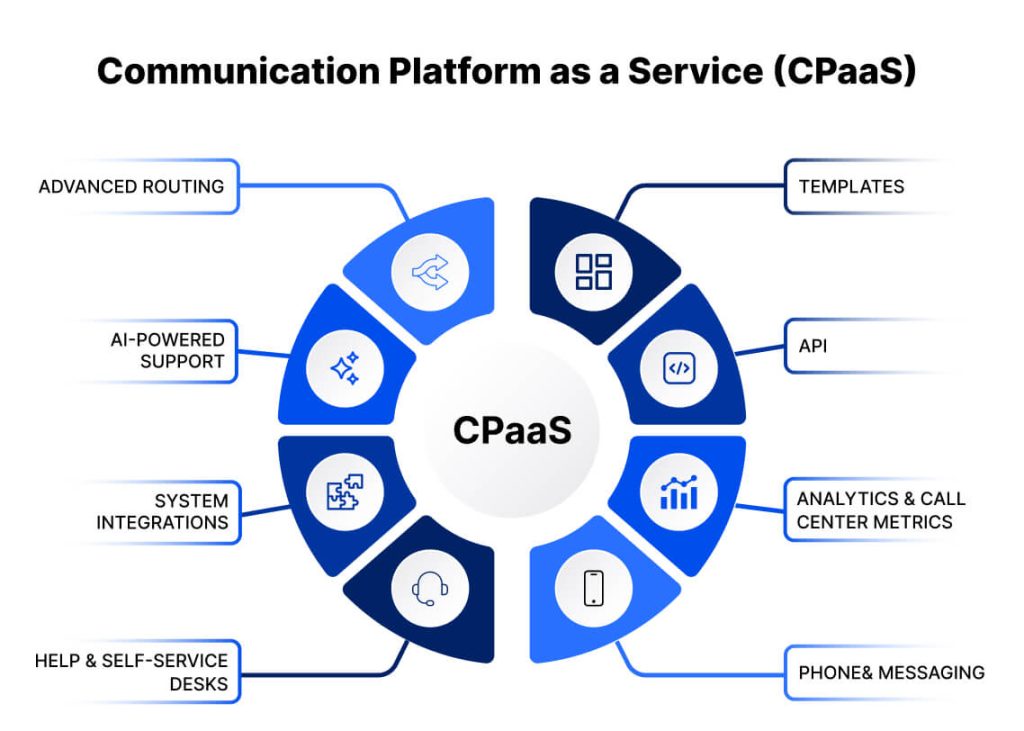
CPaaS, or CPaaS model is also a cloud-based communication platform, however, its primary aim is to provide developers with the tools and APIs to build custom communication solutions. Unlike UCaaS, CPaaS does not provide a pre-built communication solution but offers the building blocks for businesses to create their custom communication features. Statistically, the CPaaS market was valued at $14.7 billion in 2022 and is expected to grow to $303.7 billion by 2031. (Source)
Key Features of CPaaS
-
API-Driven
CPaaS provides APIs for various communication channels, such as voice calls, SMS, and messaging that developers can embed directly into their applications.
-
Customization
Another key advantage of CPaaS is the high-degree customization it offers. It enables businesses to use the provided APIs and create communication solutions that fit their specific needs.
-
Integration
CPaaS can be integrated with existing systems and applications, enabling businesses to leverage their existing infrastructure and data.
-
Scalability
Just like UCaaS, CPaaS is also scalable. However, it offers scalability on a granular level i.e. businesses can scale up or down specific features rather than a whole communication suite.
What is the Difference Between UCaaS and CPaaS?
It is true that both UCaaS and CPaaS play essential roles in modern business communication but in different ways.
UCaaS presents a complete, ready-to-use communication solution, whereas CPaaS offers the tools to create and build custom communication features.
A detailed comparison table could help you understand both communication solutions, here you go!
| Feature | UCaaS | CPaaS |
| Level of Customization | Limited customization | High customization |
| Complexity | Easy to deploy and manage | Requires development expertise |
| Time to Market | Faster time to deployment | Longer time to develop custom applications |
| Cost | Predictable subscription fees | Variable costs based on usage |
| Security | Strong security measures built into the platform | Shared responsibility model with the provider |
| Scalability | Easily scalable to accommodate growing business needs | Highly scalable to handle varying workloads |
| Integration | Integrates with other business applications (e.g., CRM, ERP) | Can be integrated with any application or platform |
Benefits of UCaaS and CPaaS Software
Both UCaaS and CPaaS offer a plethora of benefits for businesses of all sizes. Let’s take a look:
Benefits of UCaaS
-
Simplified Communication
UCaaS consolidates various communication tools into one unified platform. This helps in reducing the complexity of managing multiple communication systems as well as helps employees in easy connection and collaboration.
-
Cost Cutting
UCaaS eliminates the need for investing in on-premise hardware and infrastructure which results in lower costs and reduced maintenance overhead. It comes in subscription-based pricing leading to predictable monthly costs which helps businesses in better budgeting.
-
Modern Solution for Today’s Workforce
Remote and hybrid work culture is on a continuous rise. UCaaS appears to be an ideal solution to empower modern teams to communicate seamlessly. Using UCaaS, the remote and hybrid workforce can connect and collaborate from anywhere with an internet connection. Such a communication system offers significant advantages over conventional Unified Communications systems that come with extensive cost and slow deployment across multiple locations.
-
Enhanced Adaptability
UCaaS offers companies unparalleled flexibility in communication. Employees can seamlessly switch between different communication channels and devices, no matter from where they work. Such a level of adaptability empowers your business to quickly change according to the situation. Moreover, the diverse range of services and communication channels such as voice, video, email, social media, and text, allows employees to communicate in their preferred style and chosen channels.
Benefits of CPaaS
CPaaS comes with its own set of benefits, making up the reasons why businesses choose it.
-
Helps Businesses Become Scalable
Imagine having the freedom to scale your communication setup as per your business’s changing needs. CPaaS tools empower you to do just that. Whether your company is experiencing rapid growth or facing a downsizing trend, scaling the system is a simple process. There are no complexities of managing costly hardware and software.
-
Cost-Effective
In terms of cost, CPaaS also proves to be a beneficial solution for companies with smaller requirements. Firstly, there’s no need to burden your employees with intensive time and effort input to build a customized communication platform for your company. Rather, CPaaS allows you to seamlessly integrate the required communication features into your existing systems and apps. While this saves thousands of hours, it also saves your resources from getting exhausted.
-
High Customization
CPaaS offers a high degree of choice, customization, and control, allowing businesses to build tailored communication solutions that meet their exact needs. This means that rather than relying on a one-size-fits-all solution, companies can benefit from custom-made solutions.
Limitations of UCaaS and CPaaS
While we’ve just explored the numerous advantages offered by UCaaS and CPaaS, it’s also essential to recognize their limitations.
Limitations of UCaaS
Vendor Lock-in Causes Dependency
A downside of using a UCaaS system is that companies may become too much dependent on the UCaaS vendor. For example, if the UCaaS provider increases its service pricing or discontinues a feature, then the business has no option but to switch provider, which may cause workflow disruption and expenses. Also, the dependence upon the vendor for updates, new features, and security patches may not always align with your needs and workflow.
Limited Customization Restricts Growth
The level of customization offered by UCaaS is quite limited, especially when compared with CPaaS. Because UCaaS solutions come ready-made, there’s no chance to customize dashboards and features. For example, if a company wants to integrate with a specific third-party app with its UCaaS system, but they find that the platform doesn’t offer native integration then it restricts them from using that third-party app for their benefit.
Potential for Performance Issues
It is true that if your UCaaS provider experiences any network outages or technical issues, it is going to impact your quality of service as well. Disruptions in business communication flow may negatively affect business operations.
Inefficient Pricing
UCaaS offers the convenience of bundled channels and features, however, it may result in businesses overpaying for the features that they don’t need. Suppose you are a small business with primary needs of voice calling and messaging. However, the UCaaS provider offers a bundled package that also includes video conferencing and collaboration tools. So if you buy such a package then it means that you have to pay for features that you never use.
Limitations of CPaaS
Requires Technical Expertise
In order to develop and manage custom communication solutions using CPaaS, businesses require in-house technical experts who can integrate the functionality into the apps or systems. This includes hiring consultants or contractors, which can increase costs and complexity.
Complex Management & Maintenance
Implementing a CPaaS solution means dealing with multiple APIs, integrations, and security considerations, which makes it more complex. Moreover, in CPaaS, your staff is involved and responsible for the development and integration, the burden of managing errors and issues at times becomes quite frustrating.
May Turn Out to Be Costly
CPaaS comes at a usage-based pricing which means depending upon the specific features and integrations, the cost gets added up. So if you are a business with more calls and messages, then CPaaS could cost you more as compared to UCaaS.
When To Use CPaaS Over UCaaS?
A CPaaS solution is an excellent choice for businesses that require a high degree of customized and flexible features in their communication solutions, which are often unavailable in off-the-shelf solutions. Let’s explore some specific scenarios where CPaaS could be the preferred option:
Highly Tailored Solutions
Many companies have the need to create unique communication workflows or integrate with third-party applications. To fulfill such requirements CPaaS fits as an ideal solution. For example, if you are a healthcare provider, you may want to create a telemedicine app that offers a seamless experience for doctors and patients. Using CPaaS, you can add features like video consultation, automated appointment reminders, voice notifications, SMS reminders, etc.
Integration with Existing Systems
CPaaS is also a good choice for businesses with the need to integrate communication features with their existing systems. For example, if your company is already using a CRM system, then you may use CPaaS to embed voice and messaging capabilities directly within the CRM interface.
Dedicated Development Resources
Companies who already have resources with the necessary technical expertise can prefer CPaaS for building a sophisticated communication solution. From getting all the tools to APIs, CPaaS does the job of creating tailored solutions when you have the right development team at your disposal. For example, you are a fintech company that leverages CPaaS to build a secure messaging platform for communicating with customers and partners.
Innovative App Development
CPaaS is an excellent choice if you wish to experiment and create innovative communication solutions. While UCaaS lacks such freedom, CPaaS lets you think and create out-of-the-box solutions. For example, if you’re a gaming company that wishes to build a real-time voice chat feature for its users, then CPaaS presents to be the ideal tool.
When To Use UCaaS Over CPaaS?
If you are a business that prefers simplicity, ease of use, and minimal management, then UCaaS is best suited for you. Let’s explore some real-life scenarios where UCaaS appears as a better choice:
Comprehensive Communication Needs
Many businesses require a wide range of features in their communication solution such as voice, video, messaging, etc. UCaaS is the perfect option because it’s pre-built and provides a one-stop solution. For example, if you are an SMB with a remote workforce, then a UCaaS might be a good option to streamline communication and collaboration among teams.
Simple and Easy-to-Use Solution
Companies that don’t want the trouble of building and managing their own communication systems can use UCaaS. Suppose you are a small business owner with limited technical resources or expertise, then by opting for UCaaS, you can easily improve your team’s communication capabilities without needing to hire technical staff.
Cost-effectiveness
Often, UCaaS proves to be a cost-effective solution for businesses that don’t need extensive customization or integration. Consider the example of a startup with limited resources and budget. Such a company can benefit by choosing a UCaaS solution to get up and running quickly without exhausting its money and resources.
With this, we come to the end of various practical scenarios to use UCaaS and CPaaS, separately.
UCaaS vs CPaaS: Which One Should You Use?
Now you may ask, which one is better – UCaaS or CPaaS? Well, it totally depends on your business’s specific needs, budget, and goals. Here’s a quick comparative analysis to help you make an informed decision.
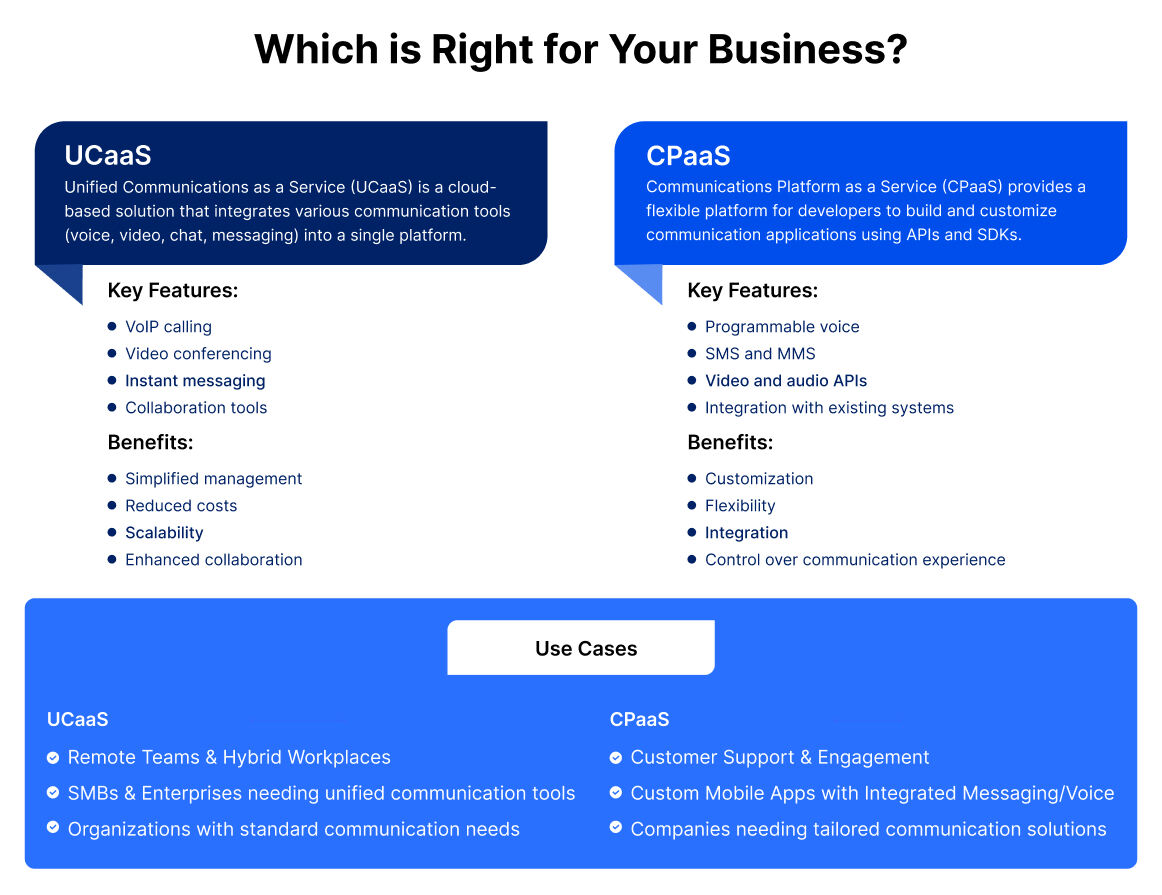
Now, let’s move ahead and see whether these two solutions can be used together.
Using UCaaS and CPaaS Together
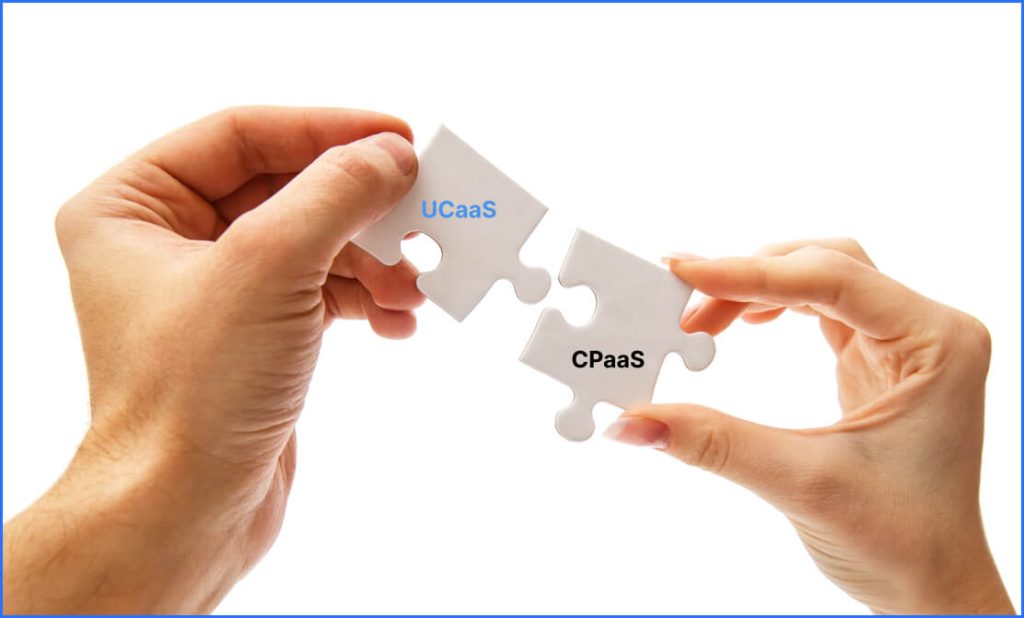
Since UCaaS and CPaaS serve different purposes, it’s often unnecessary to choose between them. The fact is that businesses can reap the benefits of both worlds by combining these two powerful solutions.
CPaaS, with its customizable nature, is more geared towards enhancing external communications such as customer interactions. It allows companies to meet the high expectations of today’s tech-savvy customers that demand top-notch service. On the other side, UCaaS is more focused on streamlining internet communication processes. It’s a unified and user-friendly solution that can be used across corporate devices and platforms.
Here comes the most appealing aspect: Both UCaaS and CPaaS are cloud-based, so they can seamlessly integrate and work together. It’s a growing trend especially for large enterprises that need both internal efficiency and external engagement.
The strengths of both these solutions make up the fact that combining them can help businesses gain significant advantages. An organization could use UCaaS for its core communication needs and CPaaS to add custom communication features to its customer-facing applications. By following a hybrid approach, the organization benefits from the ease of use of UCaaS and the flexibility and customization of CPaaS.
UCaaS vs CPaaS: Key Takeaway!
Ultimately, the choice between UCaaS vs. CPaaS depends on your unique requirements. Remember, the key to success is to invest in a robust solution with carrier-grade reliability, scalability, and top-notch support. We, at REVE, offer a carrier-grade white-label cloud PBX unified communication solution, known as REVE Cloud Telephony. It can be rebranded by service providers, enabling them to market the services under their own brand.
Sign up for a free demo to experience the utilization of our power-packed communication suite for your business.
Frequently Asked Questions
How can UCaaS improve employee productivity?
UCaaS centralizes multiple communication and collaboration tools, minimizing the time spent on switching between apps, scheduling meetings and searching for contact information.
What is the main difference between UCaaS and CPaaS?
UCaaS offers a pre-built communication platform that offers a fixed set of features, while CPaaS provides the tools to build custom solutions.
Which is more cost-effective: UCaaS or CPaaS?
UCaaS typically offers fixed, subscription-based pricing plans, while CPaaS is available on usage-based price which is usually more cost-effective for businesses with low communication volumes or specific use cases.
How long does it typically take to implement a UCaaS or CPaaS solution?
The implementation time can vary depending on the complexity of the solution and the specific requirements of the business.
How secure are UCaaS and CPaaS solutions?
Both UCaaS and CPaaS providers typically have robust security measures in place to protect customer data.
Does CPaaS fall under the SaaS category?
No, they are distinct. SaaS stands for Software as a Service, which refers to providing software applications over the internet. Some common examples include CRM and ERP systems. On the contrary, CPaaS or Communications Platform as a Service, offers APIs and SDKs, used by developers to create custom communication features into their applications.
What is the size of the CPaaS market?
CPAAS Market size was valued at USD 14.7 billion in 2022 and is poised to grow from USD 20.58 billion in 2023 to USD 303.7 billion by 2031, growing at a CAGR of 40% during the forecast period (2024-2031).
What are the future trends in UCaaS and CPaaS?
The integration of AI and Machine Learning, increased adoption of cloud-based communication, and the convergence of UCaaS and contact center solutions are some of the key trends.




























